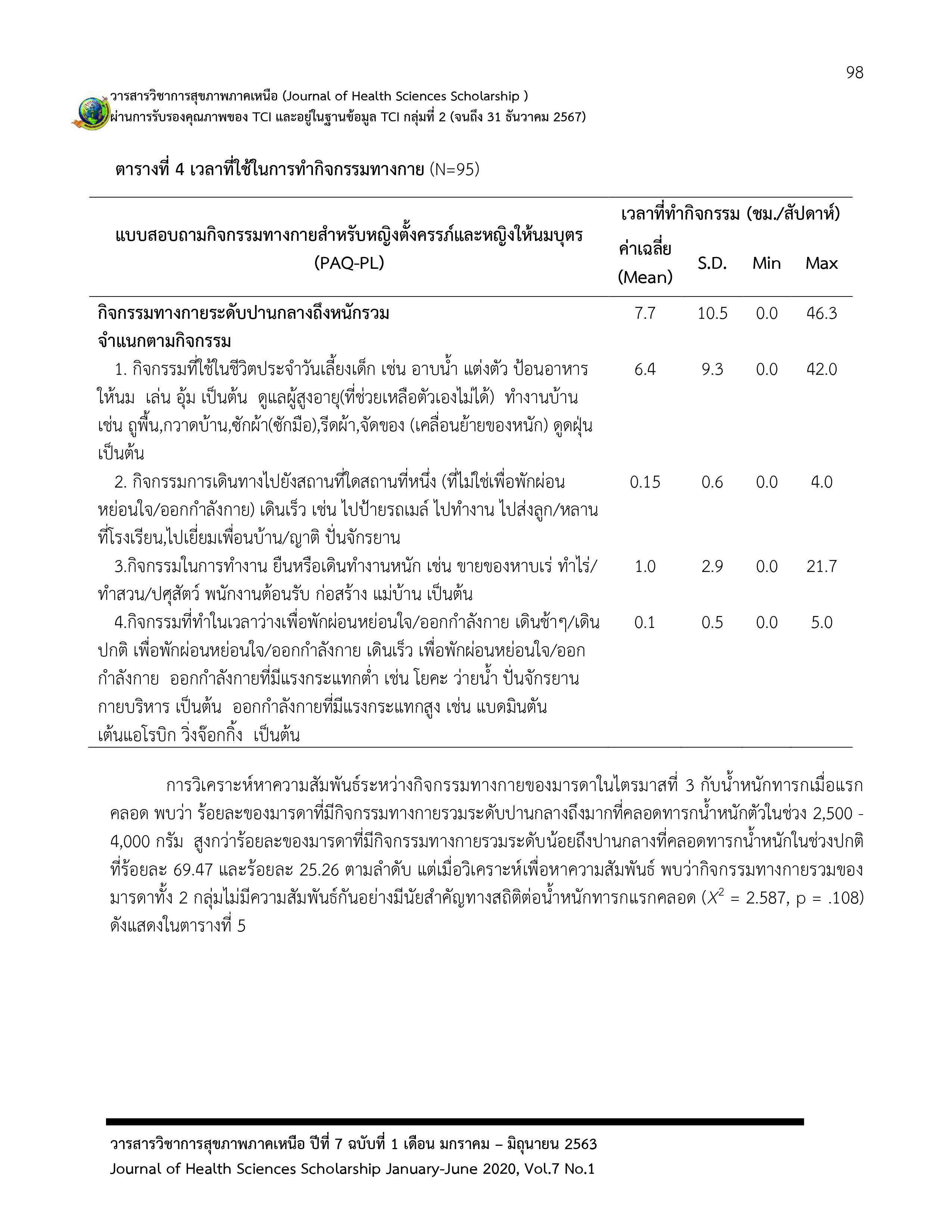ความสัมพันธ์ของกิจกรรมทางกายขณะตั้งครรภ์ในไตรมาสที่สามกับน้ำหนักทารกแรกคลอดใน โรงพยาบาลเกาะคา จังหวัดลำปาง
คำสำคัญ:
กิจกรรมทางกายขณะตั้งครรภ์, น้ำหนักทารกแรกคลอด, ออกกำลังกายขณะตั้งครรภ์บทคัดย่อ
น้ำหนักทารกแรกเกิดเป็นตัวบ่งชี้สำคัญถึงความสมบูรณ์แข็งแรงของเด็ก และความสามารถของการเกิดมีชีพ มีการศึกษาเกี่ยวกับการออกกำลังกายในหญิงตั้งครรภ์ ทำให้น้ำหนักทารกอยู่ในเกณฑ์ปกติ แต่คนไทยมีความเชื่อว่า การออกกำลังกายขณะตั้งครรภ์ หรือการมีกิจกรรมทางกายที่มากเกินไป โดยเฉพาะในช่วงไตรมาสที่ 3 ของการตั้งครรภ์ ทำให้เกิดผลเสียต่อมารดาและทารก การวิจัยครั้งนี้มีวัตถุประสงค์ เพื่อศึกษาความสัมพันธ์ของกิจกรรมทางกายของมารดาขณะตั้งครรภ์ในไตรมาสที่ 3 กับน้ำหนักทารกแรกคลอด โรงพยาบาลเกาะคา จังหวัดลำปาง เป็นงานวิจัยเชิงพรรณนา กลุ่มตัวอย่างคือ หญิงตั้งครรภ์ที่มารับบริการการคลอดที่โรงพยาบาลเกาะคาตั้งแต่เดือน พฤศจิกายน พ.ศ. 2562 – มกราคม พ.ศ. 2563 จำนวน 95 คน เครื่องมือวิจัยคือ แบบสอบถามกิจกรรมทางกายสำหรับหญิงตั้งครรภ์และหญิงให้นม ฉบับภาษาไทย วิเคราะห์ข้อมูลด้วยสถิติเชิงพรรณนา ได้แก่ ร้อยละ ค่าเฉลี่ย และส่วนเบี่ยงเบนมาตรฐาน ส่วนการวิเคราะห์หาความสัมพันธ์ของกิจกรรมทางกายกับน้ำหนักทารกแรกเกิดโดย ใช้สถิติไคว์สแควร์ (Chi-square test)
ผลการศึกษา: พบว่า ร้อยละของมารดาที่มีกิจกรรมทางกายรวมระดับปานกลางถึงมากที่คลอดทารกน้ำหนักตัวในช่วง 2,500 – 4,000 กรัม สูงกว่าร้อยละของมารดาที่มีกิจกรรมทางกายรวมระดับน้อยถึงปานกลางที่คลอดทารกน้ำหนักในช่วงปกติ ที่ร้อยละ 69.47 และร้อยละ 25.26 ตามลำดับ แต่เมื่อวิเคราะห์เพื่อหาความสัมพันธ์ พบว่ากิจกรรมทางกายรวมของมารดาทั้ง 2 กลุ่มไม่มีความสัมพันธ์กันอย่างมีนัยสำคัญทางสถิติต่อน้ำหนักทารกแรกคลอด
ข้อเสนอแนะ: การศึกษาครั้งต่อไปควรมีการศึกษาถึงปัจจัยอื่นๆที่อาจจะมีผลต่อน้ำหนักทารกแรกคลอดและเพิ่มช่วงเวลาการศึกษาเป็นทุกไตรมาส
เอกสารอ้างอิง
Baena-García, L. et al. (2019). Association of sedentary time and physical activity during pregnancy with maternal and neonatal birth outcomes. The GESTAFIT Project. Scandinavian Journal of Medicine & Science in Sports, 29(3), 407-414. doi:10.1111/sms.13337.
Beetham, K. S. et al. (2019). The effects of vigorous intensity exercise in the third trimester of pregnancy: a systematic review and meta-analysis. BMC pregnancy and childbirth, 19(1), 281.
Beta, J. et al. (2019). Maternal and neonatal complications of fetal macrosomia: systematic review and meta-analysis. Ultrasound Obstet Gynecol, 54(3), 308-318. doi:10.1002/uog.20279.
Huang, L. et al.(2018). The mediating role of placenta in the relationship between maternal exercise during pregnancy and full-term low birth weight. The Journal of Maternal-Fetal & Neonatal Medicine, 31(12), 1561-1567.
Koutsospyros, D., & Epstein, L. (2019). Pain in Pregnancy and Labor 39. Academic Pain Medicine: A Practical Guide to Rotations, Fellowship, and Beyond, 305.
Lotgering, F. K. (2014). 30+ Years of Exercise in Pregnancy. In Advances in fetal and neonatal physiology (pp. 109-116): Springer.
Mottola et al. (2018). Canadian guideline for physical activity throughout pregnancy. British Journal of Sports Medicine, 52(21), 1339-1346. doi:10.1136/bjsports-2018-100056.
Obstetricians, A. C. o., & Gynecologists. (2015). ACOG Committee Opinion No. 650: Physical activity and exercise during pregnancy and the postpartum period. Obstet Gynecol, 126(6), e135-142.
Teerapong, K., & mangkorn, p. (2017). Thailand recommwndation on physical activity, non-sedentary lifestyles and sleeping for pregnan and postpartum women ministry of public health. (in Thai).
Parent-Vachon, M. et al. (2019). The Effects of Exercise on Pain and Reproductive Performance in Female Pregnant Mice With Neuropathic Pain. Biological research for nursing, 1099800419857812.
Perales, M. et al. (2015). Exercise during pregnancy attenuates prenatal depression: a randomized controlled trial. Evaluation & the health professions, 38(1), 59-72.
Sefat, M., Mohammadi, N., & Sadeghi, A. (2019). Physical Activity and Nutritional Status in Females With Vaginal Delivery and Cesarean Section in Razi Hospital, Qazvin. The Journal of Qazvin University of Medical Sciences, 23(3), 238-249.
Srichan, W. et al. (2019). physical activity questionnaire for pregnant and lactating women, PAQ-PL. (in Thai).
Vargas-Terrones, M. et al. (2019). Physical exercise programme during pregnancy decreases perinatal depression risk: a randomised controlled trial. Br J Sports Med, 53(6), 348-353.
WHO. (2014). Global Nutrition Targets 2025: Low birth weight policy brief. [Online]. Available from
https://www.who.int/nutrition/publications/globaltargets2025_policybrief_lbw/en/.
(2018, March, 15). (in thai).

ดาวน์โหลด
เผยแพร่แล้ว
ฉบับ
ประเภทบทความ
สัญญาอนุญาต
บทความ ข้อมูล เนื้อหา รูปภาพ ฯลฯ ที่ได้รับการตีพิมพ์ในวารสารวารสารวิชาการสุขภาพภาคเหนือ ถือเป็นลิขสิทธิ์ของวารสารวารสารวิชาการสุขภาพภาคเหนือ หากบุคคลหรือหน่วยงานใดต้องการนำทั้งหมดหรือส่วนหนึ่งส่วนใดไปเผยแพร่ต่อหรือเพื่อกระทำการใดๆ จะต้องได้รับอนุญาตเป็นลายลักอักษรจากวารสารวารสารวิชาการสุขภาพภาคเหนือก่อนเท่านั้น
เนื้อหาและข้อมูลในบทความที่ลงตีพิมพ์ในวารสารวิชาการสุขภาพภาคเหนือถือเป็นข้อคิดเห็นและความรับผิดชอบของผู้เขียนบทความโดยตรงซึ่งกองบรรณาธิการวารสาร ไม่จำเป็นต้องเห็นด้วย หรือร่วมรับผิดชอบใดๆ
อนึ่ง ข้อความและข้อคิดเห็นต่างๆ เป็นของผู้เขียนบทความนั้นๆ ไม่ถือเป็นความเห็นของวารสารฯ และวารสารฯ ไม่จำเป็นต้องเห็นด้วยกับข้อความและข้อคิดเห็นใดๆ ของผู้เขียน วารสารฯ ขอสงวนสิทธิ์ในการพิจารณาตีพิมพ์ตามความเหมาะสม รวมทั้งการตรวจทานแก้ไขหรือขัดเกลาภาษาให้ถูกต้องตามเกณฑ์ที่กำหนด


